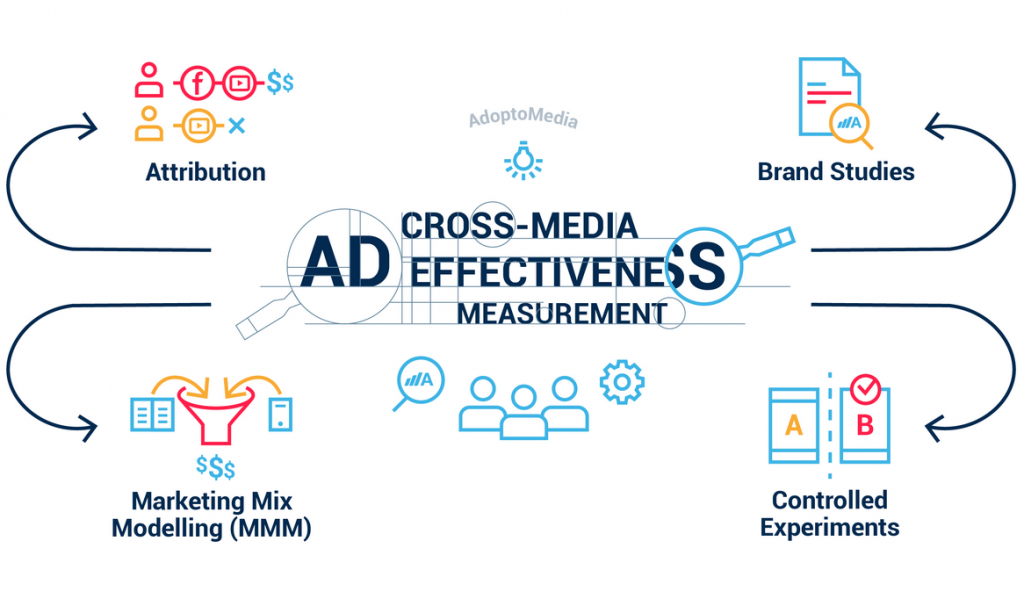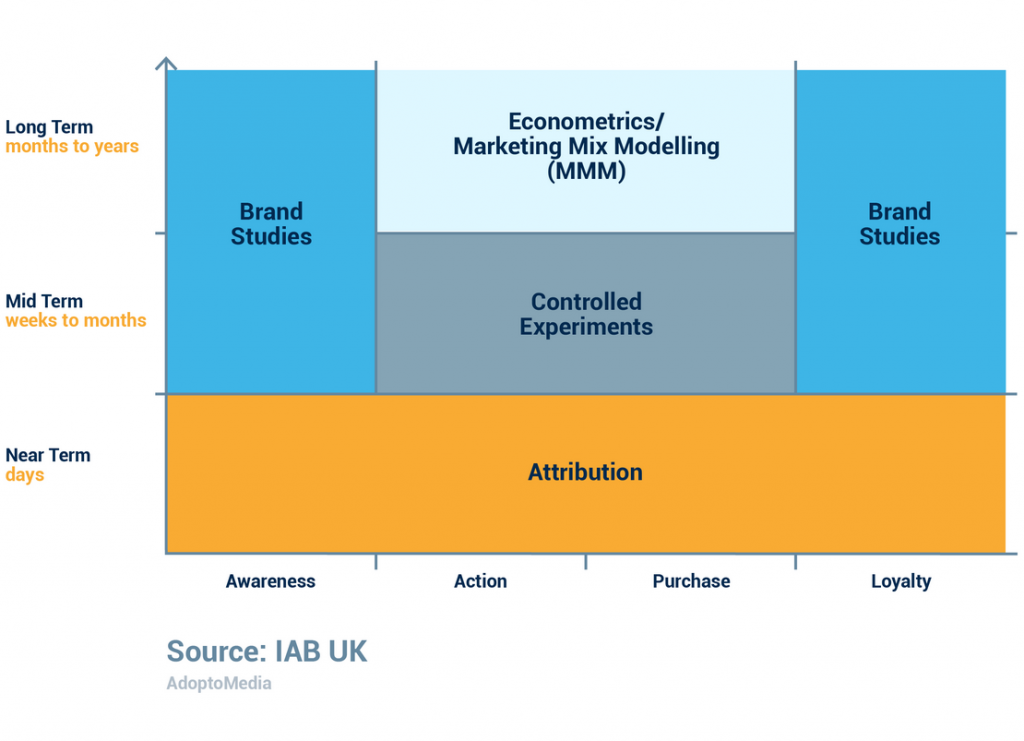
One of the topical problems in 2019 is digital advertising and cross-media measurement. Since there is a growing number of complex techniques and methodologies, but no unified approach, most companies lack expertise to deal with it. Here we cover various measurement tools and their cross-platform application.
We are trying to keep you updated on all marketing measurement trends, that’s why we prepared an article on the use of measurement tools after the phase-out of cookies and IDFA. Get ready to privacy changes and apply solutions that won’t be affected by the new conditions. See how MMM, MTA, brand studies and other approaches are going to function without third-party cookies.
Created in 1997, Interactive Advertising Bureau UK (IAB UK) is a trade association, promoting sustainable development, the best practices and standards for advertisers, agencies, and media owners. Their goal is to address challenges the industry is facing and offer some solutions. Our article is an overview of the guide for marketers on best practices today that AIB prepared with MTM. Here you will find some useful advice on what models and techniques to use for digital advertising measurement within the environment of various media, both large-scale and more granular analyses. You will see how to combine them to your best advantage and create your own measurement strategy.
There is no simple answer and solution to successful and effective advertising measurement because so many aspects need to be considered, like audience, media consumption, views, individual and combined performance of media channels, ad effectiveness and business outcomes. This article covers the last two aspects in the context of different media channels.
Strategic approach and careful planning will ensure you to avoid many problems and achieve the best outcome, and the five following steps will help you with that.
- First of all you need to define the campaign objectives and target audience. While estimating more obvious short-term results, don’t forget about long-term goals and find a way to measure them as well. Each media should have a clear purpose in the campaign.
- Then set KPIs in advance and choose relevant metrics according to the general objectives. IAB doesn’t want marketers to overestimate click-through rates, because they can be misleading and focus on short-term results.
- Use comprehensive qualitative data and take into account information gaps to get more accurate results. Try to constantly improve granularity and coverage.
- Combine the best available tools to overcome obstacles and get unbiased results.
- Use any results, even negative, as feedback and learning opportunity to improve your future marketing strategies.
Four major tools we are going to discuss are brand studies, econometrics, attribution and controlled experiments. Choosing which ones to use and how to combine them depends on your product sales cycle, share of online and offline media spend as well as other promotional tools. The tools should be combined in such a way that the results they produce don’t contradict, but compliment each other. Their combination should also cover the key steps in the customer lifecycle and different time frames, an example of which you can see in the graph below.

Brand Studies
Brand studies measure awareness, familiarity, favourability, consideration and intent through surveys that are usually carried out before and after a marketing campaign. This flexible tool is a source of insights on many aspects including reasons for sale increase, creative design and ad positioning on a web page. They are perfect for identifying long-term brand activities impact and prove to be even more helpful in developing marketing strategies if implemented on a regular basis. Due to their flexibility you can use them across various channels and compare the effectiveness of digital and offline ads, avoiding double counting and misattribution.

But despite the advantages of this tool, it doesn’t measure sales or other direct consumer actions, besides the results might be biased and inaccurate if a surveyed group is too small. You cannot be sure that the only difference between two surveyed groups is exposure to your ad, so there may be other factors that affected the result. Respondents also often forget where exactly they saw the ad, but to solve this problem other measurement tools can be used.
Econometrics and Marketing Mix Modelling
Marketing Mix Modelling (MMM) uses statistical tools to predict how different advertising (TV, OOH, print, digital and others) and other factors affects incremental sales. Marketers have been using it for a long time usually to measure the impact on offline sales, but now with the proliferation of digital channels it can be applied across various media with more granularity. A popular solution is to use MMM together with attribution, when the former tool identifies the best working media channel and the latter one helps to make short term tactical decisions. Just like brand studies, econometrics can also measure awareness, consideration and brand equity. According to Harry Davison, Facebook Client Marketing Science Manager in UK, MMM is perfect for understanding the bigger picture. With enough cross channel sales data MMM can compare the impact of offline and digital channels. But without at least two years worth of data it won’t work properly. MMM measures the contribution of each media channel separately and doesn’t reflect amplifier effect of digital. If you are trying to measure different KPIs, you need a new model for each of them, which is more complex and cost-intensive. But model building process can be automated with advanced technology; AdoptoMedia, for example, uses AI-enhanced econometric models, that include multiple KPIs at the same time.
Attribution
Attribution is used to identify which touchpoints on a customer’s journey lead to conversion. Unlike MMM, it is highly granular, doesn’t require massive sets of data to function properly and provides feedback almost in real time, which allows for creative alterations and mid-campaign tactical optimizations. In the pictures below you can see two different techniques: single touch and multi touch attribution.

It is mainly used in digital marketing, but can be also applied as an addition to MMM. Attribution can easily assess effectiveness of a single channel, especially on platforms that offer their own attribution systems. Different attribution models are intended for different objectives, for example last touch model can be used to identify the most effective touchpoint in terms of conversions, while a position based model gives you a complete picture of a customer’s journey. There are attribution models that combine both channels digital and offline, though it’s still not easy to track conversions across different platforms. And if the purchase happens offline, it adds challenge to the task, but MMM is suitable for such cases. Another problem is that attribution may give too much credit to digital channels and is helpful only with short-term tactical decisions, so don’t forget about your long term goals when using attribution. The most commonly mentioned issue with multi touch attribution is inability to create single customer view across different platforms because of the restrictions to data access. A detailed comparison of pros and cons of both MMM and Attribution will help you to make an informed decision on how to apply and combine these measurement tools depending on your objectives.
Controlled Experiments
Controlled experiments randomly assign people to a control or test group and compare the impact of an alteration in ads. The test group sees an altered advertisement, while the control group sees no change. To run such experiments you need a clear, testable hypothesis otherwise you might end up misallocating your budget. This methodology is perfect for accurate measurement of incremental sales and can be combined with other approaches. It helps to fill the gaps in data from high volume digital channels and is suitable for stress testing. For example, if MMM shows that paid social media advertising increases sales through higher organic search, controlled experiments can provide more evidence of that and make sure that you don’t waste your investments. This tool can be used as the standard to verify other methods, according to Matthew Taylor, Econometric Program Lead at Google. It is flexible and can be implemented, even though in limited cases, across digital and offline channels, especially when you need to estimate their combined impact, but for accurate results you need large control and test groups, which is often challenging.
Finally, there are two worth mentioning trends that affect and reshape measurement tools — machine learning and data privacy. While machine learning helps marketers to find patterns in large, high quality data sets, that can be used to predict KPIs, privacy restrictions seriously limit their abilities. Yet McKinsey seems to have found a way to gather customers’ data complying with GDPR.
Even though cross-media measurement is not a simple task, with strategic planning and practical tools described above you can succeed in it. Before distributing your media budget make sure that you have completed all five steps mentioned above.
Adoptomedia offers you an innovative tool that can automate media budget allocation and save you both time and money. We can launch all the measurement models above within your software complying with all regulations. Our flexible platform can be easily integrated in your existing IT infrastructure. CheckMedia Solution has already helped companies to simplify their work with the contractors and increase ROMI by at least 10-20% and measure it in real time.
